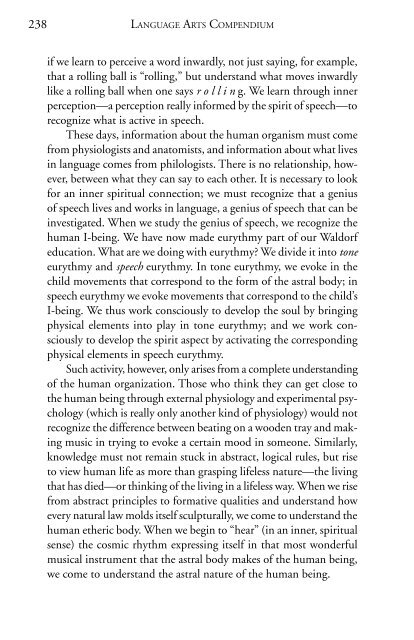Teaching Language arTs in The WaLdorf schooL
Teaching Language arTs in The WaLdorf schooL
Teaching Language arTs in The WaLdorf schooL
Create successful ePaper yourself
Turn your PDF publications into a flip-book with our unique Google optimized e-Paper software.
238<br />
<strong>Language</strong> Arts Compendium<br />
if we learn to perceive a word <strong>in</strong>wardly, not just say<strong>in</strong>g, for example,<br />
that a roll<strong>in</strong>g ball is “roll<strong>in</strong>g,” but understand what moves <strong>in</strong>wardly<br />
like a roll<strong>in</strong>g ball when one says r o l l i n g. We learn through <strong>in</strong>ner<br />
perception—a perception really <strong>in</strong>formed by the spirit of speech—to<br />
recognize what is active <strong>in</strong> speech.<br />
<strong>The</strong>se days, <strong>in</strong>formation about the human organism must come<br />
from physiologists and anatomists, and <strong>in</strong>formation about what lives<br />
<strong>in</strong> language comes from philologists. <strong>The</strong>re is no relationship, however,<br />
between what they can say to each other. It is necessary to look<br />
for an <strong>in</strong>ner spiritual connection; we must recognize that a genius<br />
of speech lives and works <strong>in</strong> language, a genius of speech that can be<br />
<strong>in</strong>vestigated. When we study the genius of speech, we recognize the<br />
human I-be<strong>in</strong>g. We have now made eurythmy part of our Waldorf<br />
education. What are we do<strong>in</strong>g with eurythmy? We divide it <strong>in</strong>to tone<br />
eurythmy and speech eurythmy. In tone eurythmy, we evoke <strong>in</strong> the<br />
child movements that correspond to the form of the astral body; <strong>in</strong><br />
speech eurythmy we evoke movements that correspond to the child’s<br />
I-be<strong>in</strong>g. We thus work consciously to develop the soul by br<strong>in</strong>g<strong>in</strong>g<br />
physical elements <strong>in</strong>to play <strong>in</strong> tone eurythmy; and we work consciously<br />
to develop the spirit aspect by activat<strong>in</strong>g the correspond<strong>in</strong>g<br />
physical elements <strong>in</strong> speech eurythmy.<br />
Such activity, however, only arises from a complete understand<strong>in</strong>g<br />
of the human organization. Those who th<strong>in</strong>k they can get close to<br />
the human be<strong>in</strong>g through external physiology and experimental psychology<br />
(which is really only another k<strong>in</strong>d of physiology) would not<br />
recognize the difference between beat<strong>in</strong>g on a wooden tray and mak<strong>in</strong>g<br />
music <strong>in</strong> try<strong>in</strong>g to evoke a certa<strong>in</strong> mood <strong>in</strong> someone. Similarly,<br />
knowledge must not rema<strong>in</strong> stuck <strong>in</strong> abstract, logical rules, but rise<br />
to view human life as more than grasp<strong>in</strong>g lifeless nature—the liv<strong>in</strong>g<br />
that has died—or th<strong>in</strong>k<strong>in</strong>g of the liv<strong>in</strong>g <strong>in</strong> a lifeless way. When we rise<br />
from abstract pr<strong>in</strong>ciples to formative qualities and understand how<br />
every natural law molds itself sculpturally, we come to understand the<br />
human etheric body. When we beg<strong>in</strong> to “hear” (<strong>in</strong> an <strong>in</strong>ner, spiritual<br />
sense) the cosmic rhythm express<strong>in</strong>g itself <strong>in</strong> that most wonderful<br />
musical <strong>in</strong>strument that the astral body makes of the human be<strong>in</strong>g,<br />
we come to understand the astral nature of the human be<strong>in</strong>g.

















